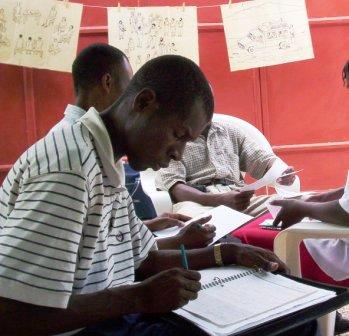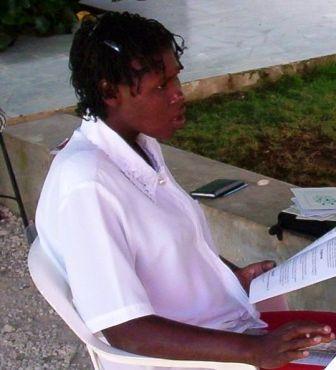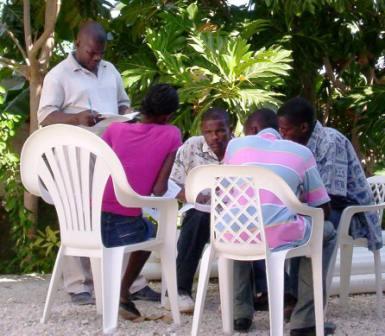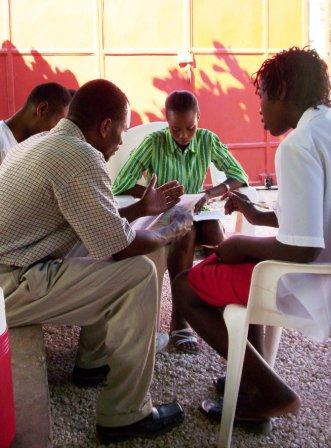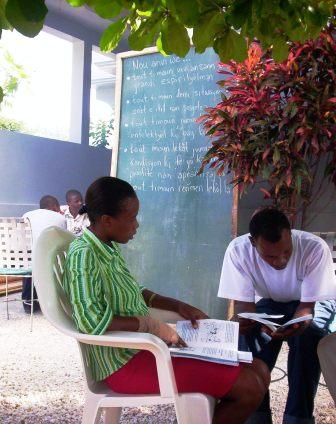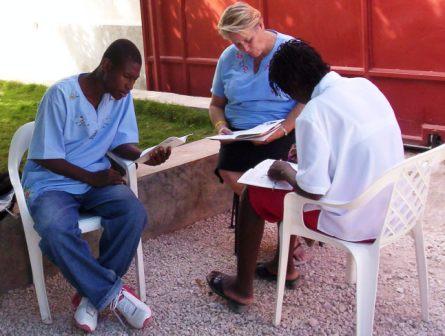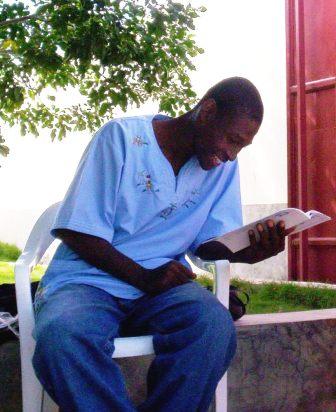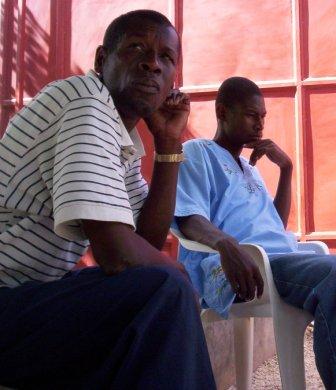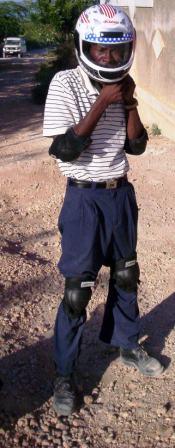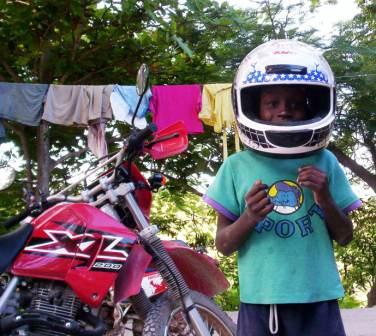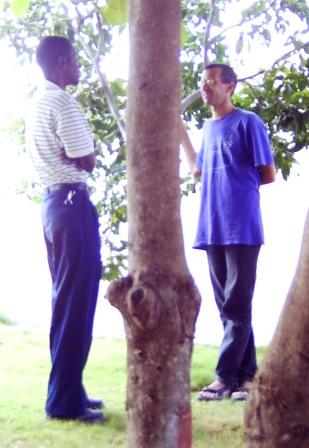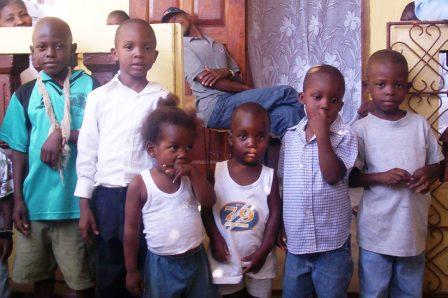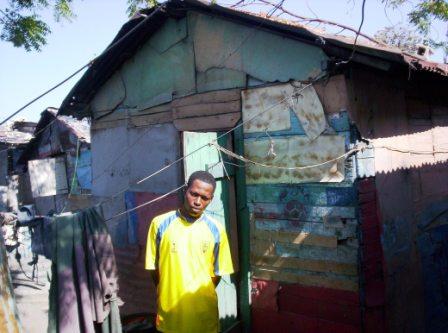I have to admit that I was a little disappointed to see American peanut butter on the table for breakfast in the priest’s guesthouse in Cerca Carvajal.
Disappointed and a little surprised. It must be a nuisance to keep a supply. I didn’t see anything in Cerca that could be called a store, much less anything that sells standard American groceries. Even in Ench, which is a hard ninety minutes away by truck, such an item might be difficult to come by. It’s likely enough that the large plastic jars of Jif are bought in Okap or Pòtoprens, hours away in one direction or the other.
And it’s strange that anyone would make that effort, because Haitians produce such wonderful peanut butter. It’s made, as far as I can tell, all over the country. And since Cerca is an area where lots of peanuts are grown, I figured that acquiring a delicious, locally-produced supply would be easy.
The church group I was in Cerca with had been there many times, so I asked them whether they had tasted Haitian peanut butter, or manba. When they said that hadn’t, I thought I would get to work.
The next morning, I went to the market early to have coffee, and asked the coffee merchant whether I would find someone selling jars of manba in the market later that day. She said that I would not, but the merchant next to her immediately chimed in: If I wanted to buy manba, she’d be happy to make it for me. I could come back to pick it up later in the day. And as we continued talking, I learned something.
I love manba. I really do. I think I could pretty much live on the stuff. I especially like it when it’s made with the very hot peppers that many Haitians grind right into it. It’s a surprising taste for someone who grew up with Skippy and the like, but I think it’s wonderful.
So I asked the woman to be sure to add peppers, and she answered, “We don’t make it that way in Cerca.” She went on to explain that, in Cerca Carvajal, manba is typically made with a little sugar, some cinnamon, and ginger. I had never heard of such a thing, but I was very happy to give it a try. It turns out, it’s great.
The experience reminded me that even within Haiti, a small enough country, there are cultural differences. When I tell my friends in Ka Glo, for example, that the folks around Twoudinò snack on fried horse meat they stare in gaping-mouthed wonder. When they hear that, in parts of the central plateau, people saddle and ride bulls instead of horses, donkeys, and mules, they are just as surprised.
The cultural differences between a group of Americans who come to visit a community in rural Haiti and the Haitians they’re visiting can, of course, be much greater. Those differences were what brought Frémy and me to Cerca Carvajal.
We were invited there by parishioners of a Catholic church in the Richmond, Virginia, area that has had a partnership with the parish in Cerca for a number of years. Groups from the Richmond church visit annually. They come with medical workers to run a two-day clinic. They also provide financial support to help run the parochial school and the church itself. Over the years, they’ve found their ties to the Haitian community that they visit abundantly rewarding, but frustrating as well. Father Ketnet, the priest who hosts them speaks English well, but other members of the Cerca community do not. All communication has had to be through Father Ketnet. The folks from Richmond have had little chance to actually speak with other people from Cerca Carvajal.
It’s not that they distrust Father Ketnet. Far from it. They seem to have a very good relationship with him. But they want something broader and richer, something that would allow them to learn from and respond to the whole community that they feel so attached to and that would allow the people in Cerca, whose lives so touch theirs, to feel a little more connected to them, too.
Frémy was asked to facilitate a large gathering at which members of the two groups would speak to one another without priestly intervention. I would be his lead translator. He would be introducing a method called Open Space. It’s a way to run a meeting without fixing its agenda in advance. Participants are invited to propose a series of topics at the start of the meeting. Each topic becomes the theme for a small group discussion. Multiple such discussions are then held as the same time. Participants choose the one whose topic interests them.
Or they don’t. A good deal of what makes Open Space work is the freedom it offers to participants. They come and go as they please. They’re not even encouraged to stay put once they enter a group. Someone might wander into one small group discussion ten minutes late, get up after five minutes of listening, and that walk off to join another. Or even just hang around without entering into any of the small groups at all. In the language of Open Space, it’s called the Law of Two Feet: If you’re not gaining from or contributing to a conversation, use your two feet to take you someplace else. It creates an ambiance that’s as unfamiliar to many of us as peanut butter with hot pepper mixed in. No one is in charge. Folks wander around. It can look and feel chaotic.
But the seeming-disorderliness of the ambiance is just the point. Because it is the loosening of the framework that a fixed agenda, clear leadership, and regimented procedures normally provide that opens up a free space where people can organize themselves to pursue the questions and tasks that really interest them. Open Space works because it invites people who are together because they are interested in something to exploit their own interest, their own passion, so that they can take responsibility for addressing the issues and solving the problems that they see as facing them.
The folks from Richmond were hoping that a meeting that broke up into separate little working groups would create an opportunity for more direct dialogue with their counterparts from Cerca Carvajal because Father Ketnet would be able to be in one small group at most. Also, paying attention to the topics that folks from Cerca propose might help them understand better what their Haitians friends were hoping for. The only things limiting what people could talk about would be their interest and their imagination.
But there would be problems. First of all, I could not do all the translating. We would have to hire a group of translators, and English speakers don’t grow on trees out in the Haitian countryside. We addressed this by inviting strong English speakers from Ench to join me as translators. I would translate Frémy’s facilitation from Creole to English, and help with other parts of the translating as well, but when participants divided into small groups, the translation team would divide with them, assuring that there would be one of us in as many different places as could be.
Using translators in the small groups, however, is tricky. Spontaneity and free flow are important parts of the atmosphere that makes Open Space work, and a translator, even a pretty good one, is almost bound to interfere with both. It is too easy for a translator to become the center of attention, making decisions about who speaks when. When translators are inexperienced and participants are also unused to speaking through translators, things are much harder. People can tend say more in each speech than the translator can remember, so things need to be repeated if they are not to be lost and that can further clog things up.
We had what appeared to be a bigger problem, however. When we got to Cerca on Wednesday afternoon, we learned that no one had yet been invited to the meeting scheduled for Friday morning. So when Father Ketnet asked at dinner that night what the maximum number of participants was, and explained that he thought 80-100 would come – if that was ok with us – I thought he was nuts.
But it turns out he can mobilize his people. There might well have been almost a hundred people – including Frémy, thirteen Virginians, and me – packed into the parish meeting house by the time things got going. Just going through introductions took a lot of time.
There’s not much to be said about what might seem like the important question: Namely, How did it go? Open Space always goes well in a way, almost by definition. As long as the person or group convening it has the ability to put things in the participants’ hands, the process can’t fail.
I don’t say this lightly. It’s certainly possible that an Open Space meeting could fail to lead to the specific consequences that those organizing it envision. But bringing about a predetermined effect is not what the process is designed for. It’s designed, rather, to free those who participate to pursue what they want.
And what these people wanted was, mostly, just to talk. The participants from Cerca wanted to share their problems and their hopes with their visitors and to feel heard by them. They also had specific questions about some of the activities that the Virginian parish sponsors. The visitors, for their part, wanted to express their interest and their appreciation to a community that has been sharing its life with them for a number of years, and to take some first steps towards understanding that community better. The small group conversation I translated was certainly lively and seemed pretty frank.
It’s hard to tell where things will go next. The Virginian group appears committed to Cerca Carvajal for the long term. Ideally, that would mean that they’ll have lots of opportunities for many more conversations.
Also ideally, it will mean that they’ll get to eat years of Cerca’s wonderful manba as well.
